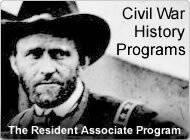
Parallel Portraits
The Smithsonian Associates Civil War E-Mail Newsletter, Volume 7, Number 5
The photographs produced by Mathew Brady's studio are the best known and most reproduced images of the Civil War. But, there is another Civil War photographer who remains almost unrecognized and all but forgotten.
Originally from New Hampshire, Andrew J. Russell was raised in New York where his family worked in canal and railroad construction. Andrew became a painter and began taking photographs to use in lieu of sketches to create his paintings. It wasn't long before he replaced his career as a painter with that of a photographer.
At age 32 in 1862, Russell enlisted in the Union Army as a captain in the 141st New York Volunteers. Because of his familiarity with bridges and his art and photography background, Russell was assigned to Army Engineer General Herman Haupt's U.S. Military Railroad Construction Corps. There his task was to create a photographic record of Haupt's construction projects.
During his lifetime, Russell's photographs were praised as documenting modern technology and many considered them works of art. Where Brady's field photographs were taken after major battles and often were staged, Russell was where the action was. He photographed the fresh battle sites of Fredericksburg and Petersburg; burial scenes as they occurred; and shortly after Appomattox, Russell captured the haunted sight of a burning Richmond, somber views that Americans still contemplate.
After the war, both Mathew Brady and Andrew Russell realized that the same photographs that brought the Civil War to the people now were rejected. No one wanted reminders of those terrible years. It was obvious that there no longer was a market for cartes de visite to exchange with loved ones in the field of battle, or for photographic reprints of their bodies as they lay there. As a result, Brady-- whose failing eyesight forced him to abandon photography, and as his wife was dying--went bankrupt.
The post-war years for Russell proved just the opposite. Russell hired on as a photographer for Leslie's Illustrated and for the Union Pacific Railroad. During several stints out west, he brought along one stereo and one 30-pound view camera, lenses, tents used for darkrooms, dozens of 10x13 and 4x8 glass plates, and dozens of bottles of chemicals used to process the plates. He housed these things in a covered wagon that he guided up the hills and down the gullies--wherever the construction crews led him. It was Russell who took the famous photograph of the joining of the Union Pacific and Central Pacific railroads at Promontory Point, Utah, on May 10, 1869.
At about the same time that Brady's collection of negatives was sold for greenhouse glass, Russell sold his negatives to an individual named O. C. Smith. Smith erased Russell's name from this work, and almost from American memory, by crediting himself instead of Russell for the photos. Brady's collection, on the other hand, eventually was rescued and deposited with the Library of Congress, where today it lives on-line and available to the world. Although Russell had a successful career after the war and lived well, Mathew Brady did not live so well, but he is better remembered.

